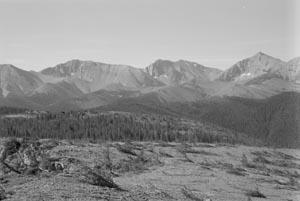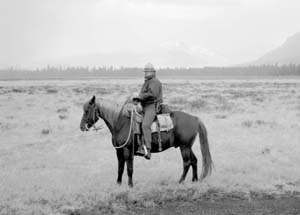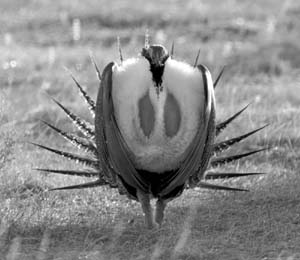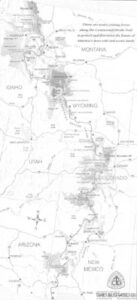Frank Clifford
- 1999

Fellowship Title:
- The Continental Divide Trail
Fellowship Year:
- 1999

The Blackfeet’s Lost Acres
A dozen Blackfeet Indians and one white man sit in an aspen grove up against the backbone of the world watching a horse die. This is a land of spirits and portents. Things that happen here take on a heightened significance. The slow, agonizing death of an injured pack horse is not a sign to be ignored. The Thunder God is supposed to live in a cave up here, and he has little patience with blasphemers. As the Blackfeet and I sit in gloomy silence, I wonder if the Indians still worry about such things, and if they now think bringing in a white man was a big mistake. We have plenty of horses to carry packs and people, but I fear the trip is over. The mountains of the Badger Two Medicine in northern Montana, just south of Glacier National Park. It is a wilderness region sacred to the Blackfeet. Tribal traditionalists fear desecration by energy companies that want to drill for oil and gas and by mechanized recreation, increasingly popular along the Continental

Fighting Battles for Grizzlies
YELLOWSTONE NATIONAL PARK–For 20 seasons, the simple life was its own reward for Bob Jackson, the only resident law enforcement officer in the most remote wilderness outpost of the lower 48 states–this park’s Thorofare district. Ranger Bob Jackson, who patrols on horseback, says he identifies with the park’s grizzlies: “Those bears are a unique living link with our untamed, pioneer heritage, and they deserve a place out here.” The woodwind echoes of shistling elk, the lacy imprint of grizzly bear tracks in autumn snow, the grandeur and solitude made up for the two-room cabin, the frigid outhouse, the $10,000 salary, the lack of pension and medical benefits, the wilderness scofflaws who poisoned his horses and periodically try to get him fired. It is all part of a mystique he revels in as one of the last lawmen still chasing down outlaws on horseback. “Action Jackson” is perhaps Yellowstone’s most revered and reviled back country park ranger, poacher hunter and champion of the grizzly bear. These days, new threats to the wilds he patrols every summer

Saving the Sage Grouse
They are nature’s own Greek chorus — plumed performers, dancing and chanting in a Dionysian frenzy, celebrating fertility, foreshadowing tragedy. Their own. The sage grouse has been dubbed the spotted owl of the plains. The sage grouse’s future depends on the willingness of Wyoming oil, gas and livestock industries, which owns 90% of the land, to reform their ways. Environmentalist’s have petitioned to have the grouse listed under the endangered species act. A male sage grouse engages in a mating dance to establish territory and find mates on a “lek” or mating ground in early morning sunlight in Wyoming. Male sage grouse puffed up in its annual spring mating dance. Photo by Anacleto Rapping Los Angeles Times It is dawn in the Jack Morrow Hills, a patch of pimples on the edge of Wyoming’s Great Divide Basin, a mesmerizingly barren expanse of sage that one 19th century traveler said only “a mad poet” could love. During their mating dance, the strutting sage grouse flare their tails like peacocks in brown camouflage and croon their own

Continental Divide Trail
Caught in a thicket of ancient enmities, the Continental Divide National Scenic Trail stops here in northern New Mexicos Piedra Lumbre basin – a river valley of silvery cottonwood, yellow tipped sage and deceptive serenity. Once completed, the trail will be the longest transcontinental trek in the U.S. The tranquil beauty of the Piedra Lumbre, flanked by the burnt umber battlements of the Canjilon Mountains would make for one of the most scenic passages along the 3,200 mile route. Rio Arriba county commissioner Moises Morales stands beside a mural celebrating his part in the 1967 Northern New Mexico land rights rebellion. But the people who inhabit this valley do not want a trail threading through land they have clung to jealously since Philip III of Spain left their ancestors here to deal with harsh winters, hostile Indians and a succession of Yankee profiteers. Northern New Mexico is crisscrossed with trails, its destiny is bound up with them. The Camino Real from Mexico brought Juan de Onate, the explorer who escorted the first settlers in 1598.
